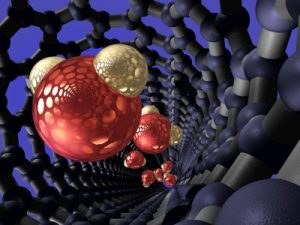Nanomedicine for cancer therapy
NPEP Newsletter, October 2016
 Cancer is known to be a chronic public disease worldwide. It is responsible for more than 6 million deaths per year globally. Research estimates that the cancer death cases will be more than double (12 million) by 2020.
Cancer is known to be a chronic public disease worldwide. It is responsible for more than 6 million deaths per year globally. Research estimates that the cancer death cases will be more than double (12 million) by 2020.
The number of cases is constantly increasing, even with the significant cancer therapeutics available. For the past 50 years, effort and money has been put toward combatting cancer, but little or no improvement in effective treatment has been made.
Chemotherapy is a well-known technique for cancer therapy. This therapy has many side-effects, and repetition of treatment is common. The main downside is that this therapy does not guarantee remediation of cancer. Radiation therapy is also not an efficient method of cancer remediation. For these reasons, new methods for cancer therapy in the field of nanotechnology should be developed. Polymeric nanomedicine could be a solution to cancer therapy.
Cancer therapy via chemotherapy requires anticancer drug delivery to cancer tissues and cells. This includes a drug delivery system which should hold an anticancer drug in the blood for longer periods, and finally release the drug at the cancer site.
In order to significantly improve cancer therapy, new cancer drugs, new research based knowledge about cancer and new novel biomedical technologies will be required. Therefore, close collaborations among clinicians, biological and material scientists, as well as biomedical engineers should be developed. A field in which all these professionals can collaborate is nanotechnology.
At the nanoscale, the properties of materials are found to often differ from the same materials at larger scales. The advantage of nanomaterials is that characteristics such as their magnetic properties and their melting points can be altered by nanotechnology, without changing their chemical compositions.
Nanotechnology is a growing and expanding field which has many applications. Among those applications, the nanotechnology that is involved in the treatment, diagnosis, monitoring and control of biological systems is referred to as nanomedicine. This name was given by the National Institute of Health (Bethesda, MD, USA).
Nanomedicine may include but is not limited to nanoparticles, nanomachines, nanofibres, nanosensors, and other nanoscale microfabrication-based entities. Examples of nanomedicine devices include gold nanoshells, iron oxide nanocrystals, and quantum dots.
Gold nanoshells act as both diagnostic and therapeutic agents. Iron oxide nanocrystals have clinically been used to detect and characterise the lymph nodes in lung, breast, prostate and endometrium cancer patients. Quantum dots are semiconductor nanocrystals and have unique properties that make them attractive as fluorescent imaging agents due to their ability to exhibit broad excitation spectra, narrow emission spectra, and longer fluorescence lifetimes as compared to imaging agents.
These nanomaterials have limited application in medicine due to their toxicity, instability, and lack of selectivity for the disease site. Due to the shortfalls of these nanomaterials, researchers have incorporated biocompatible polymers on the surfaces of diagnostic nanomedicines. Polymers such as poly ethylene glycol (PEG), N-2-hydroxypropyl methacrylamide co-polymers, poly vinyl pyrrolidone, poly ethyleneimine, hyaluronic acid, chitosan, dextran and poly aspartic acid and their derivatives have been investigated for their potential use in polymer therapeutics. PEG minimises the interfacial energy in an aqueous environment and circulates in the blood for a longer period of time. This increases the possibility that it will reach the targeted cancer cells. The ability of the nanomaterials to target cancer cells can be improved by further incorporating ligands or targeting moieties to chemically reactive functional groups on the PEG polymer. This improves the diagnostic nanomedicines which are available.
Dineo Bopape
A leader in nanotechnology and drug delivery
Nano News hosts a popular writing workshop for scientists
Prof. Mhlanga appointed as the head of the H2020 Programme
Drug delivery of insulin through nanotechnology
Nanomedicine in SA: the future and the concerns
The nano drug delivery system in South Africa
The age of nanorobots in medicine
Nanomedicine for cancer therapy
Nanotechnology research on oil compounds
2nd Symposium on nanomedicine and HIV/AIDS in South Africa
Symposium on nanomedicine and cancer in South Africa
SAASTA’s Young Science Communicators competition
The International Union for Crystallography Congress 2017 in Hyderabad
67th Lindau Nobel Laureates Meeting
Australian X-ray Analytical Association 2017 Conference, Workshops and Exhibition (AXAA-2017)
6th Annual Gauteng Nanosciences Young Researcher’s Symposium (NYRS)
